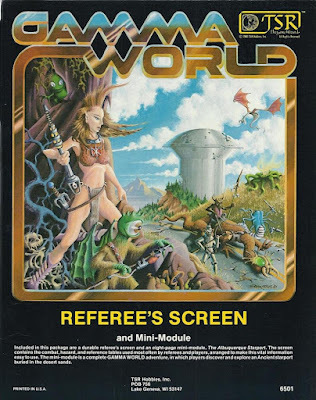The Setting of Gamma World (Part II)
 The first edition of Gamma World was published in 1978, but did not receive any official support from TSR until 1981, when the company released both the Referee's Screen and Legion of Gold. What makes the former worthy of discussion is its inclusion of an 8-page "mini-module," written by Paul Reiche III and developed by Lawrence Schick. Entitled "The Albuquerque Starport," it offers not really an adventure but the description of three different locales, each of which could serve as the basis for one or more scenarios on their own, or in tandem.
The first edition of Gamma World was published in 1978, but did not receive any official support from TSR until 1981, when the company released both the Referee's Screen and Legion of Gold. What makes the former worthy of discussion is its inclusion of an 8-page "mini-module," written by Paul Reiche III and developed by Lawrence Schick. Entitled "The Albuquerque Starport," it offers not really an adventure but the description of three different locales, each of which could serve as the basis for one or more scenarios on their own, or in tandem.
As its title suggests, "The Albuquerque Starport" takes the futuristic setting of Gamma World as a fact. Indeed, the mini-module places it front and center, since the three locales it describes are the starport itself, a passenger space shuttle, and a space station in orbit above the Earth. All of these locales include details and elements that hit home that GW's apocalypse occurred several hundred years in our future. Indeed, I'll go so far as to say that "The Albuquerque Starport" is the most clearly futuristic of all the products released for the first edition of the game.
That said, the starport section is probably the weakest in this regard, since it is clearly modeled on what commercial airports were like at the time it was written. There is, for example, a restaurant (with cash register), a gift shop, and baggage claim area. However, in many cases, Reiche made an effort to "futurize" what he describes. Thus, the restaurant is "totally automated" and served by robots, as is the kitchen that serves it ("filled with all manner of cooking apparatus, including a quark-powered cooker, a selenium stone, and a maxi-boron boiler."). You'll still find references to "paperback novels" in the gift shop, as well as paper, pencils, and keys – why not staged I.D. devices? – that reflect a 20th century reality, alongside the robots, broadcast power receiving stations, and nervium-12 anti-theft gas.
The description of the shuttle is short, but, by necessity, it demonstrates the high-tech nature of the pre-apocalyptic world. Aboard the vessel, there are "tri-vid amusement games," a null-grav jump shaft instead of an elevator, "acceleration couches," and similar wonders of the Ancients. Like so many things in the mini-module, the shuttle is fully automated, which is convenient, since it means the player characters aren't required to figure out its workings in order to be able to make use of it. That's both a dramatic contrivance and precondition for their reaching the third section of the mini-module, the space station.
The space station is where "The Albuquerque Starport" tells us the most about the setting of Gamma World. The docking pods of the station, whose floors are covered by "bright shag rug[s]," – a concession to the 1970s? – have posters that advertise "the splendors of the cloud cities of Jupiter, the intra-ring pleasure ports of Saturn, and many other famous vacation spots around the solar system." With that, Reiche paints a picture of a solar system-spanning human civilization that I've always found very intriguing.
Shortly thereafter, he describes "matter transmitter pads" that "once transported shuttle passengers to the large outbound starships located farther out in orbit," Star Trek-style. The reference to starships is suggestive, implying that mankind had in fact traveled beyond the aforementioned pleasure ports of Saturn to other star systems. This implication is proven to be correct, when the dreaded Canpous plague is described as "an alien disease brought back to Earth by long-range scoutships in the early 2300's." The star Canopus is more than 300 light years away from our solar system. Even if these long-range scoutships were unmanned, it suggests, at the very least, that, prior to the End, humans were well on their way toward exploring the galaxy.
Finally, the space station section includes "The Moon Survival Store," where "specialized survival gear for travelers going to the moon" can be found – once again implying regular travel beyond the Earth. There are a variety of high-tech pharmaceuticals to be found, in addition to clothing made from "rayon, nylon, dacron, ultron, and other man-made fabrics." None of these things play a significant role aboard the station and are unlikely to be important to the player characters. Nevertheless, they help to paint a picture of a futuristic world – or at least what someone from the late '70s or early '80s might have imagined such a world to look like.
As a kid, I simply adored "The Albuquerque Starport," though I doubt I could have articulated why beyond, "I like spaceships" or something equally banal. Now, as I look at it more critically, I realize that its appeal lies in the way it brings the futuristic elements of Gamma World's setting to the foreground. In addition, it expands that setting beyond Earth and starts my mind wondering, "What happened to Earth's interplanetary settlements and installations? Did they survive the End intact or did they suffer their own catastrophes?" That it does both these things in the span of only six pages of text makes it all the more remarkable.
James Maliszewski's Blog
- James Maliszewski's profile
- 3 followers



